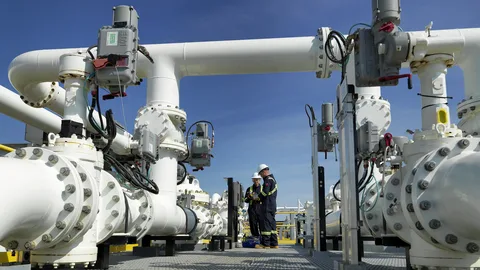Modern Pipelines: Balancing Efficiency, Safety, and Sustainability

Introduction
The US Oil & Gas Pipeline Market forms the backbone of the nation’s energy logistics, ensuring efficient transportation of crude oil, natural gas, and refined products across vast distances. As energy demand continues to grow, pipelines remain the most reliable and cost-effective mode of transport for hydrocarbons. The market is undergoing a period of modernization, focusing on digital monitoring, enhanced safety systems, and capacity expansion to meet the evolving energy landscape. With new exploration projects, LNG exports, and the transition toward cleaner fuels, the US pipeline sector is set for significant transformation in both scale and technology.
Market Drivers
The primary driver of the US Oil & Gas Pipeline Market is the growing energy demand across industrial, commercial, and residential sectors. The continuous expansion of shale production — especially in the Permian, Marcellus, and Bakken basins — has increased the need for efficient midstream infrastructure.
Investments in pipeline safety, corrosion prevention, and leak detection systems are also propelling market growth. The integration of digital technologies like SCADA systems, IoT sensors, and real-time data analytics enhances operational efficiency and minimizes downtime.
Additionally, the rising export of liquefied natural gas (LNG) and refined petroleum products has accelerated the construction of cross-border and inter-state pipeline networks, further supporting the industry’s expansion.
Market Challenges
Regulatory hurdles and environmental concerns pose major challenges to pipeline development. Obtaining federal and state-level approvals for new projects often involves complex environmental assessments, delaying implementation timelines.
Public opposition related to land rights, water safety, and carbon emissions adds further pressure on project execution.
Maintenance of aging infrastructure is another pressing issue — many pipelines in the US are several decades old, requiring constant monitoring and replacement to ensure safety and reliability.
Price volatility in the oil and gas markets can also impact pipeline investments, leading to delays or cancellations in large-scale projects.
Market Opportunities
Despite the challenges, opportunities are expanding through digital innovation and renewable integration. Advanced monitoring systems leveraging drones, artificial intelligence, and fiber-optic sensing are revolutionizing maintenance and inspection processes.
The market is also witnessing a growing trend toward hydrogen and carbon dioxide (CO₂) pipeline networks, driven by decarbonization initiatives and carbon capture projects.
Strategic partnerships between pipeline operators and technology firms are fostering the development of smart pipeline systems capable of predictive maintenance and optimized flow management.
Moreover, the increasing focus on exporting natural gas to global markets offers immense potential for midstream infrastructure growth, especially in LNG corridors connecting Gulf Coast terminals.
Regional Insights
The Gulf Coast region leads the US pipeline market, driven by its strong concentration of refineries, export terminals, and offshore production facilities. Texas remains the epicenter for pipeline construction due to its proximity to major shale basins and international ports.
The Midwest and Northeast regions are seeing growing investments in natural gas pipelines to support industrial growth and residential energy demand. The Marcellus and Utica shale formations, in particular, continue to fuel infrastructure expansion.
The Western region, though smaller in volume, focuses on pipeline modernization and renewable energy integration to meet environmental standards.
Future Outlook
The future of the US Oil & Gas Pipeline Market will be shaped by digitalization, sustainability, and energy diversification. Automation and smart monitoring technologies will redefine operational safety and efficiency.
Hydrogen pipelines and CO₂ transport infrastructure are expected to gain prominence as the US moves toward carbon neutrality.
Increased collaboration among public agencies, private firms, and technology providers will streamline regulatory compliance and accelerate project deployment.
As renewable energy and traditional hydrocarbons coexist in the future energy mix, the US pipeline network will continue to evolve into a more adaptive, intelligent, and resilient infrastructure system.
Conclusion
The US Oil & Gas Pipeline Market remains an indispensable pillar of national energy infrastructure. With innovation driving digital monitoring and renewable integration, the market is transitioning toward safer, smarter, and more sustainable operations. Despite environmental and regulatory challenges, continued investments in modernization and capacity expansion ensure a strong outlook for the sector. As the nation redefines its energy logistics for the 21st century, pipelines will remain the crucial link connecting production with consumption — powering growth and sustainability together.
- Art
- Causes
- Crafts
- Dance
- Drinks
- Film
- Fitness
- Food
- Игры
- Gardening
- Health
- Главная
- Literature
- Music
- Networking
- Другое
- Party
- Religion
- Shopping
- Sports
- Theater
- Wellness



